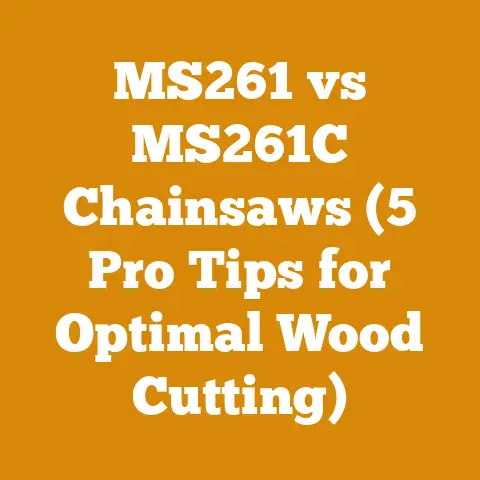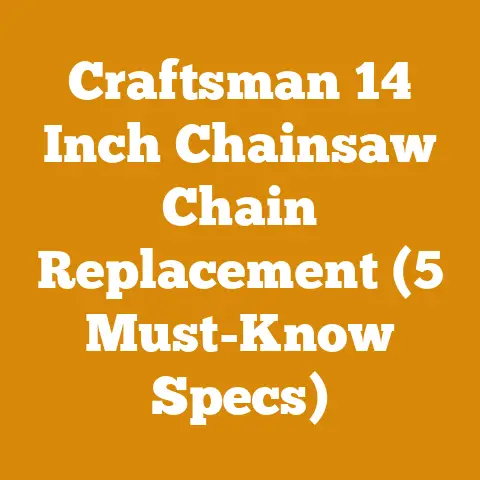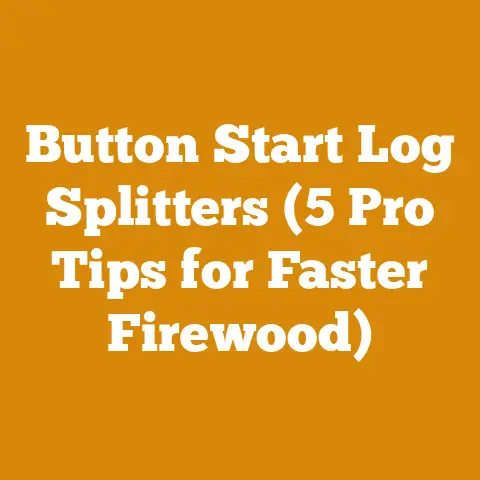Slab Cutting Boards: DIY Hardwood Chopping Blocks (Pro Tips)
Isn’t it strange how something as rugged as a chainsaw, a tool born from the heart of the industrial revolution, can be used to create something as refined and beautiful as a hardwood slab cutting board? It’s a paradox, a collision of raw power and delicate craftsmanship. And that, my friends, is precisely what makes crafting your own DIY hardwood chopping block so incredibly rewarding.
I’ve spent years in the wood processing world, from the biting chill of winter logging operations to the sawdust-filled air of my own workshop. I’ve learned a thing or two about transforming raw timber into functional art. Today, I’m going to share my pro tips on creating slab cutting boards that are not only beautiful but also durable and food-safe. Get ready to roll up your sleeves, because we’re diving deep into the world of hardwood, chainsaws, and the satisfying art of the DIY chopping block.
Slab Cutting Boards: DIY Hardwood Chopping Blocks (Pro Tips)
The allure of a handcrafted cutting board is undeniable. It’s more than just a surface for chopping; it’s a statement piece, a testament to your skill and appreciation for natural materials. Plus, let’s be honest, store-bought cutting boards often lack that unique character and robust quality you can achieve with a DIY project.
Why Choose a Slab Cutting Board?
Slab cutting boards offer a rustic, natural aesthetic that’s hard to replicate. They showcase the wood’s natural grain patterns, knots, and imperfections, making each piece truly one-of-a-kind. Beyond aesthetics, slab cutting boards are often thicker and more substantial than traditional cutting boards, providing a stable and durable surface for heavy-duty chopping and slicing. Think about that Thanksgiving turkey carving – wouldn’t it look grand on a thick slab of cherry wood?
From a practical standpoint, a well-maintained hardwood slab cutting board can last for generations. They are naturally antimicrobial, easy to clean, and can be refinished to restore their beauty and functionality.
Understanding Wood Species: Choosing the Right Hardwood
The heart of any great cutting board is the wood itself. Not all hardwoods are created equal, and selecting the right species is crucial for durability, safety, and aesthetics.
- Hardness: This is measured by the Janka hardness scale, which indicates the force required to embed a steel ball into the wood. A higher Janka rating generally means a more durable and scratch-resistant cutting board. However, extremely hard woods can be brittle and dull knives faster.
- Porosity: Lower porosity is desirable, as it makes the wood less absorbent and easier to clean. Woods with open pores can harbor bacteria and are more prone to staining.
- Toxicity: Some woods contain natural oils or compounds that can be toxic if ingested. It’s essential to choose food-safe hardwoods for cutting boards.
- Aesthetics: Consider the grain pattern, color, and overall appearance of the wood. Do you prefer a light, clean look or a rich, dark tone?
Here are some popular and recommended hardwoods for cutting boards:
- Maple: A classic choice, maple is hard, durable, and has a tight grain, making it resistant to bacteria. Sugar maple (Acer saccharum) is particularly prized for its hardness and stability. Janka hardness rating: ~1450 lbf.
- Cherry: Known for its rich, reddish-brown color and beautiful grain, cherry is a moderately hard and durable option. It’s also relatively easy to work with. Janka hardness rating: ~950 lbf.
- Walnut: A luxurious choice, walnut boasts a dark, chocolate-brown color and striking grain patterns. It’s a moderately hard and stable wood. Janka hardness rating: ~1010 lbf.
- Beech: European Beech (Fagus sylvatica) is a dense, hard wood with a fine grain and light color. It’s a popular choice in Europe for food preparation surfaces. Janka hardness rating: ~1300 lbf.
- Acacia: Increasingly popular due to its availability and affordability, acacia is a durable hardwood with a distinctive grain. However, ensure it’s sourced from sustainable plantations. Janka hardness rating: ~1700 lbf.
Woods to Avoid:
- Softwoods: Pine, fir, and cedar are too soft and porous for cutting boards. They will absorb moisture, harbor bacteria, and are easily damaged.
- Exotic Woods with Potential Toxicity: Some exotic woods, like cocobolo or rosewood, contain oils that can cause allergic reactions or be toxic if ingested. Always research the safety of a wood species before using it for a cutting board.
- Treated Wood: Never use pressure-treated or chemically treated wood for cutting boards.
Sourcing Your Slab: From Forest to Workshop
Finding the perfect slab is a crucial first step. You have a few options:
- Local Sawmills: This is my preferred method. Visiting local sawmills allows you to hand-select slabs, often at a lower cost than retail lumberyards. You can also build relationships with millers who can alert you to unique or interesting pieces. Don’t be afraid to ask about the history of the wood – where it came from, how long it’s been drying, etc.
- Lumberyards: Lumberyards typically offer a wider selection of hardwoods in various thicknesses and grades. However, prices may be higher than at sawmills.
- Online Retailers: Several online retailers specialize in selling wood slabs. This can be a convenient option if you don’t have access to local sawmills or lumberyards. However, you won’t be able to inspect the slab in person before purchasing.
- Salvaged Wood: Reclaimed wood from old barns, buildings, or fallen trees can be a great source of unique and characterful slabs. However, be sure to thoroughly inspect salvaged wood for nails, screws, and other debris. You’ll also need to ensure it’s properly dried and free of pests.
What to Look for in a Slab:
- Dimensions: Choose a slab that’s large enough for your desired cutting board size. Remember to account for trimming and squaring.
- Thickness: I recommend a minimum thickness of 1.5 inches for a durable and stable cutting board. Thicker slabs (2-3 inches) offer a more substantial feel and are less likely to warp.
- Moisture Content: The slab should be properly dried to prevent warping, cracking, and fungal growth. Aim for a moisture content of 6-8% for indoor use. You can use a moisture meter to check the moisture content of the wood.
- Defects: Inspect the slab for cracks, knots, voids, and other defects. While some imperfections can add character, avoid slabs with significant structural damage. Small cracks can often be stabilized with epoxy resin.
- Grain Orientation: Consider the grain orientation of the wood. End-grain cutting boards (where the end grain of the wood is exposed) are known for their durability and self-healing properties. However, they require more complex construction techniques.
My Story: I once salvaged a beautiful piece of black walnut from a fallen tree on a neighbor’s property. It was a massive slab, riddled with cracks and imperfections. Most people would have dismissed it as firewood. But I saw potential. After carefully drying the slab, filling the cracks with epoxy resin, and meticulously sanding it smooth, I transformed it into a stunning cutting board that became a centerpiece in my kitchen. It’s a testament to the beauty that can be found in unexpected places.
Chainsaw Milling: From Log to Slab (Optional)
If you have access to a log and the necessary equipment, you can mill your own slabs using a chainsaw mill. This is a more involved process, but it allows you to control every aspect of the slab’s creation.
Equipment Needed:
- Chainsaw: A powerful chainsaw with a long bar (at least 24 inches) is essential.
- Chainsaw Mill Attachment: This attachment guides the chainsaw to create consistent, parallel cuts.
- Guide Rails: Straight, rigid rails are used to guide the chainsaw mill. You can use aluminum extrusions, steel angles, or even straight boards.
- Safety Gear: Always wear appropriate safety gear, including a helmet, eye protection, hearing protection, gloves, and chaps.
The Process:
- Prepare the Log: Clean the log and remove any bark or debris. Secure the log to prevent it from rolling.
- Set Up the Guide Rails: Attach the guide rails to the log, ensuring they are parallel and level.
- Make the First Cut: The first cut is the most challenging, as it establishes the reference plane for subsequent cuts. Take your time and ensure the cut is straight and consistent.
- Mill the Slabs: Once the first cut is made, you can use the chainsaw mill to cut the remaining slabs. Adjust the thickness of the slabs as desired.
- Debark and Edge: Remove the bark and uneven edges from the slabs using a drawknife or other tools.
Important Considerations:
- Chainsaw Milling is Dangerous: Chainsaw milling is a physically demanding and potentially dangerous activity. Always follow safety precautions and wear appropriate safety gear.
- Chainsaw Maintenance: Keep your chainsaw properly maintained and sharpened. A dull chain will make the milling process more difficult and increase the risk of kickback.
- Wood Drying: Properly drying the slabs is crucial to prevent warping and cracking.
Data Point: According to the USDA Forest Service, air-drying lumber can take several months to years, depending on the wood species, thickness, and climate. Kiln-drying can significantly reduce drying time, but it requires specialized equipment.
Preparing the Slab: Flattening, Sanding, and Shaping
Once you have your slab, it’s time to prepare it for finishing. This involves flattening, sanding, and shaping the slab to create a smooth, even surface.
Flattening:
Slabs often have uneven surfaces due to warping or twisting. Flattening the slab is essential for creating a level cutting surface. There are several methods for flattening a slab:
- Hand Planing: Using a hand plane is a traditional method for flattening wood. It requires skill and patience, but it can produce excellent results.
- Router Sled: A router sled is a jig that allows you to flatten a slab using a router. The router sled consists of a flat base and two parallel rails that guide the router.
- Jointer/Planer: If you have access to a jointer and planer, you can use them to flatten the slab. However, most jointers and planers have a limited width capacity, so you may need to use a wider machine or a combination of methods.
Sanding:
Sanding is essential for creating a smooth, even surface. Start with a coarse grit sandpaper (e.g., 80 grit) to remove any imperfections or scratches. Gradually move to finer grits (e.g., 120, 180, 220) to achieve a smooth, polished surface.
Shaping:
Once the slab is flattened and sanded, you can shape the edges to your desired profile. You can use a router with a variety of edge-forming bits to create rounded, chamfered, or decorative edges. You can also use hand tools, such as a spokeshave or block plane, to shape the edges.
Case Study: I recently worked on a project where I used a router sled to flatten a large walnut slab. The slab was severely warped, with a difference of over an inch between the highest and lowest points. After several passes with the router sled, I was able to flatten the slab to within 1/16 of an inch. The result was a perfectly flat and stable surface for a dining table.
Filling Voids and Cracks: Epoxy Resin Techniques
Slabs often have voids, cracks, and knots that can detract from their appearance and structural integrity. Epoxy resin can be used to fill these imperfections, creating a smooth, durable, and visually appealing surface.
Choosing the Right Epoxy:
- Food-Safe Epoxy: It’s crucial to use a food-safe epoxy resin for cutting boards. Look for epoxies that are certified as food-safe by organizations like the FDA or NSF.
- Clear vs. Tinted Epoxy: Clear epoxy allows the natural color and grain of the wood to show through. Tinted epoxy can be used to add color or create a contrasting effect.
- Viscosity: Choose an epoxy with a low viscosity for filling small cracks and voids. A higher viscosity epoxy is better for filling larger voids or creating thicker layers.
The Process:
- Prepare the Surface: Clean the surface of the slab and remove any loose debris. Sand the edges of the voids or cracks to create a smooth transition.
- Mix the Epoxy: Carefully mix the epoxy resin and hardener according to the manufacturer’s instructions.
- Pour the Epoxy: Slowly pour the epoxy into the voids or cracks. Use a heat gun or torch to remove any air bubbles.
- Cure the Epoxy: Allow the epoxy to cure completely according to the manufacturer’s instructions.
- Sand the Epoxy: Once the epoxy is cured, sand it flush with the surface of the slab. Start with a coarse grit sandpaper and gradually move to finer grits.
Unique Insight: Adding pigments to epoxy can create stunning visual effects. Consider using metallic powders, translucent dyes, or even glow-in-the-dark pigments to create a truly unique cutting board.
Finishing: Protecting and Enhancing the Wood
The final step in creating your DIY hardwood chopping block is applying a finish. The finish protects the wood from moisture, stains, and scratches, while also enhancing its natural beauty.
Choosing the Right Finish:
- Food-Safe Oil: Mineral oil is a popular choice for cutting boards. It’s food-safe, easy to apply, and relatively inexpensive. However, it requires regular reapplication.
- Beeswax Finish: A mixture of mineral oil and beeswax provides a more durable and water-resistant finish than mineral oil alone.
- Hard Wax Oil: Hard wax oils are a blend of natural oils and waxes that provide a durable and water-resistant finish. They are more expensive than mineral oil or beeswax, but they offer superior protection.
- Avoid Film-Forming Finishes: Avoid using film-forming finishes, such as polyurethane or varnish, on cutting boards. These finishes can chip, crack, and peel, and they are not food-safe.
The Process:
- Prepare the Surface: Ensure the surface of the slab is clean, dry, and smooth.
- Apply the Finish: Apply the finish liberally to the slab, following the manufacturer’s instructions.
- Allow the Finish to Absorb: Allow the finish to absorb into the wood for the recommended time.
- Wipe Off Excess Finish: Wipe off any excess finish with a clean cloth.
- Reapply as Needed: Reapply the finish as needed to achieve the desired level of protection and sheen.
Actionable Takeaway: I always recommend applying multiple coats of finish to a new cutting board, allowing each coat to dry thoroughly before applying the next. This helps to build a durable and water-resistant barrier.
Maintenance and Care: Keeping Your Cutting Board in Top Shape
Proper maintenance is essential for extending the life of your DIY hardwood chopping block.
- Cleaning: Wash the cutting board with warm, soapy water after each use. Avoid using harsh detergents or abrasive cleaners.
- Drying: Dry the cutting board thoroughly after washing. Do not leave it soaking in water.
- Oiling: Regularly oil the cutting board with mineral oil or beeswax finish to prevent it from drying out and cracking.
- Sanitizing: Occasionally sanitize the cutting board with a solution of white vinegar and water.
- Refinishing: If the cutting board becomes scratched or stained, you can refinish it by sanding it smooth and reapplying a finish.
Data Point: According to a study by the University of California, Davis, wood cutting boards are actually more hygienic than plastic cutting boards. Wood has natural antimicrobial properties that help to kill bacteria.
Safety First: Protecting Yourself During the Process
Working with wood and power tools can be dangerous. Always follow safety precautions and wear appropriate safety gear.
- Eye Protection: Wear safety glasses or a face shield to protect your eyes from flying debris.
- Hearing Protection: Wear earplugs or earmuffs to protect your hearing from loud noises.
- Dust Mask: Wear a dust mask or respirator to protect your lungs from wood dust.
- Gloves: Wear gloves to protect your hands from splinters and chemicals.
- Chaps: When chainsaw milling, wear chaps to protect your legs from chainsaw cuts.
- Safe Work Practices: Follow safe work practices when using power tools. Read the manufacturer’s instructions and never operate tools under the influence of drugs or alcohol.
Compelling Phrase: Remember, a moment of carelessness can lead to a lifetime of regret. Prioritize safety in every step of the process.
Cost Analysis: DIY vs. Store-Bought
Creating your own DIY hardwood chopping block can be a cost-effective alternative to purchasing a store-bought board. However, the cost will depend on the materials you use and the tools you already own.
DIY Costs:
- Wood Slab: $20 – $100+ (depending on species, size, and quality)
- Epoxy Resin: $20 – $50
- Finish: $10 – $30
- Sandpaper: $10 – $20
- Other Supplies: $10 – $20
Total DIY Cost: $70 – $220+
Store-Bought Costs:
- Hardwood Cutting Board: $50 – $300+ (depending on species, size, and quality)
Analysis:
While the initial cost of a DIY project may be higher due to the purchase of materials and supplies, you can often save money in the long run by creating multiple cutting boards from a single slab. You also have the satisfaction of creating something unique and personalized.
Troubleshooting Common Problems
Even with the best planning and preparation, you may encounter problems during the process of creating your DIY hardwood chopping block. Here are some common problems and their solutions:
- Warping: Warping is a common problem with wood slabs. To prevent warping, ensure the slab is properly dried and stored in a stable environment. If the slab warps, you can try to flatten it using a router sled or hand plane.
- Cracking: Cracking can occur if the wood dries too quickly or if it’s subjected to excessive stress. To prevent cracking, dry the wood slowly and avoid exposing it to extreme temperature or humidity changes. If a crack develops, you can fill it with epoxy resin.
- Air Bubbles in Epoxy: Air bubbles can form in epoxy resin during the mixing and pouring process. To remove air bubbles, use a heat gun or torch to gently heat the epoxy.
- Uneven Finish: An uneven finish can occur if the surface of the slab is not properly prepared or if the finish is not applied evenly. To fix an uneven finish, sand the surface smooth and reapply the finish.
Conclusion: The Satisfaction of Crafting Your Own
Creating your own DIY hardwood chopping block is a rewarding experience that combines craftsmanship, creativity, and a deep appreciation for natural materials. It’s a chance to transform a raw slab of wood into a functional work of art that you can enjoy for years to come.
I’ve seen firsthand the pride and satisfaction that comes from creating something with your own hands. Whether you’re a seasoned woodworker or a beginner, I encourage you to give it a try. With a little patience, skill, and the right guidance, you can create a stunning and durable cutting board that will be the envy of all your friends and family. So, grab your chainsaw (carefully!), select your hardwood, and get ready to embark on a wood processing journey that’s as satisfying as it is practical. You might just find that you have a knack for turning raw timber into treasured heirlooms.






